Kazoku
The Kazoku (華族, "Magnificent/Exalted lineage") was the hereditary peerage of the Empire of Japan, which existed between 1869 and 1947.
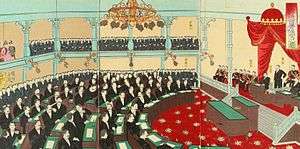
Origins
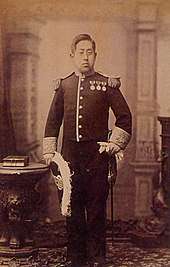
Following the Meiji Restoration of 1868, the ancient court nobility of Kyoto, the Kuge (公家), regained some of its lost status. Several members of the kuge, such as Iwakura Tomomi and Nakayama Tadayasu, played a crucial role in the overthrow of the Tokugawa shogunate,[1] and the early Meiji government nominated kuge to head all seven of the newly established administrative departments.
The Meiji oligarchs, as part of their Westernizing reforms, merged the kuge with the former daimyōs (大名, feudal lords) into an expanded aristocratic class on 25 July 1869, to recognize that the kuge and former daimyō were a social class distinct from the other designated social classes of shizoku (氏族, former samurai) and heimin (平民, commoners). Itō Hirobumi, one of the principal authors of the Meiji constitution, intended the new kazoku peerage to serve as a political and social bulwark for the "restored" emperor and the Japanese imperial institution. At the time, the kuge and former daimyō consisted of a group of 427 families.
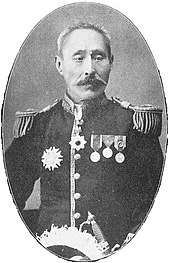
All members of the kazoku without an official government appointment in the provinces were initially obliged to reside in Tokyo. By the end of 1869, a pension system was adopted, which gradually displaced the kazoku from their posts as provincial governors and as government leaders. The stipends promised by the government were eventually replaced by government bonds.
Development
- Prince, the equivalent of a Duke (公爵, kōshaku)
- Marquess (侯爵, kōshaku)
- Count, the equivalent of an Earl (伯爵, hakushaku)
- Viscount (子爵, shishaku)
- Baron (男爵, danshaku)
There were several categories within the kazoku. The initial rank distribution for kazoku houses of kuge descent depended on the highest possible office to which its ancestors had been entitled in the imperial court. Thus, the heirs of the five regent houses (go-sekke) of the Fujiwara dynasty (Konoe, Takatsukasa, Kujō, Ichijō and Nijō) all became princes, the equivalent of a European duke, upon the establishment of the kazoku in 1884. The heads of eight other families (Daigo, Hirohata, Kikutei, Koga, Saionji, Tokudaiji, Ōinomikado and Kasannoin) all with the rank of seiga, the second rank in the kuge, became marquesses at the same time. Those family heads in the third tier of the kuge and with the rank of daijin became counts; heads of families in the lowest three tiers (those in the ranks of urin, mei and han) typically became viscounts, but could also be ennobled as counts.
Other appointments to the two highest ranks in the kazoku—prince and marquess—from among the kuge were also made to reward certain kuge families for their roles in the Meiji Restoration, for taking a prominent role in national affairs or for their close degree of relationship to the Imperial family. Thus the head of the seiga-ranked Sanjo house became a prince in 1884; the heads of the Tokudaiji and the Saionji houses were advanced to the rank of prince from the rank of marquess in 1911 and 1920, respectively. In recognition of his father's role in the Meiji Restoration, Iwakura Tomosada, the heir of noble Iwakura Tomomi and whose family had been in the fourth tier of kuge nobility with the rank of urin was ennobled as a prince in 1884. Nakayama Tadayasu, the Meiji Emperor's maternal grandfather and also from an urin-ranked family, was ennobled as a marquess. The head of the Shō family, the former royal family of the Ryūkyū Kingdom (Okinawa), was given the title of marquess. When the Korean Empire was annexed in 1910, the House of Yi was mediatized as an incorporated and therefore subordinate kingship (王).
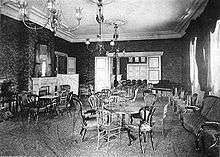
Excluding the Tokugawas, the initial kazoku rank distribution for the former daimyō lords depended on rice revenue: those with 150,000 koku or more became marquesses, those with 50,000 koku or more become counts, and those with holdings rated below 50,000 koku became viscounts. The head of the Tokugawa clan, Tokugawa Iesato, became a prince, the heads of primary Tokugawa branch houses (shinpan daimyō) became marquesses, the heads of the secondary branches became counts and the heads of more distant branches became viscounts. The head of the Matsudaira (Fukui Domain) branch was raised to the rank of marquess from the rank of count in 1888. In 1902, the former shōgun Tokugawa Yoshinobu was created a prince, and the head of the Mito Shinpan house was raised to the same rank, prince, in 1929.
Of the other former daimyō clans, the heads of the Mōri (Chōshū Domain) and Shimazu (Satsuma Domain) clans were both ennobled as princes in 1884 for their role in the Meiji Restoration; the Yamauchi (Tosa Domain) clan was given the rank of marquess. The heads of the main Asano (Hiroshima Domain), Ikeda (Okayama and Tottori Domains), Kuroda (Fukuoka Domain), Satake (Kubota Domain), Nabeshima (Saga Domain), Hachisuka (Tokushima Domain), Hosokawa (Kumamoto Domain) and Maeda (Kaga Domain) clans became marquesses in 1884. Notably, the head of the main family line of the Date clan, which had formerly ruled the extensive Sendai Domain, was only ennobled as a count and was thus denied a hereditary seat in the House of Peers; this was likely due to the domain's prominent role as the leader of a coalition against the Imperial forces during the Boshin War. In 1891, the head of the Date-Uwajima family (Uwajima Domain), a cadet branch of the clan which had remained loyal to the Emperor during the conflict, was raised to the rank of marquess, having been ennobled as a count in 1884.
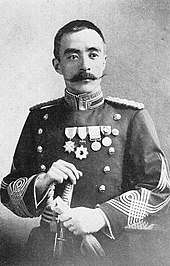
Many of those who had significant roles in the Meiji Restoration, or their heirs, were ennobled. Ito Hirobumi and Yamagata Aritomo were ennobled as counts in 1884, promoted to marquesses in 1895 and finally became princes in 1907. The heirs of Okubo Toshimichi and Kido Takayoshi, two of the three great nobles of the Meiji Restoration, were ennobled as marquesses in 1884, followed by the heirs of samurai general-politician Saigō Takamori in 1902.
Succession and numbers
As in the British peerage, only the actual holder of a title and his consort were considered members of the kazoku. The holders of the top two ranks, prince and marquess, automatically became members of the House of Peers in the Diet of Japan upon their succession or upon majority (in the case of peers who were minors). Counts, viscounts and barons elected up to 150 representatives from their ranks to sit in the House of Peers.
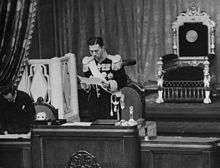
Under the Peerage Act of 7 July 1884, pushed through by Home Minister and future first Prime Minister Itō Hirobumi after visiting Europe, the Meiji government expanded the hereditary peerage with the award of kazoku status to persons regarded as having performed outstanding services to the nation. The government also divided the kazoku into five ranks explicitly based on the British peerage, but with titles deriving from the ancient Chinese nobility:
Usually, though not always, titles and hereditary financial stipends passed according to primogeniture. Unlike in European peerage systems, but following traditional Japanese custom, illegitimate sons could succeed to titles and estates. Also, to prevent their lineages from dying out, heads of kazoku houses could (and frequently did) adopt sons from collateral branches of their own houses, whether in the male or female lines of descent, and from other kazoku houses whether related or not. Also unlike European custom, the adopted heir of a peer could succeed to a title ahead of a more senior heir in terms of primogeniture. A 1904 amendment to the 1889 Imperial Household Law allowed minor princes (ō) of the imperial family to renounce their imperial status and become peers (in their own right) or heirs to childless peers.
Initially there were 11 non-imperial princes, 24 marquesses, 76 counts, 324 viscounts and 74 barons, for a total of 509 peers.[2] By 1928, through promotions and new creations, there were a total of 954 peers: 18 non-imperial princes, 40 marquesses, 108 counts, 379 viscounts and 409 barons. The kazoku reached a peak of 1016 families in 1944.[3]
The 1946 Constitution of Japan abolished the kazoku and ended the use of all titles of nobility or rank outside the immediate Imperial Family. Since the end of the war, many descendants of the kazoku families continue to occupy prominent roles in Japanese society and industry.[4]
The Kazoku Kaikan (華族会館), or Peers' Club, was the association of the high nobility. It had its headquarters in the Rokumeikan building. After 1947 it was renamed the Kasumi Kaikan (霞会館) and is located in the Kasumigaseki Building in Kasumigaseki.[5]
See also
Notes
- Peter Francis Kornicki, The emergence of the Meiji state (1998), p. 115
- Jansen, The Making of Modern Japan, p. 391.
- Kodansha Encyclopedia of Japan, p. 1194.
- Lebra, Above the Clouds: Status Culture of the Modern Japanese Nobility.
- Jordan, Mary (May 21, 1997). "The Last Retreat of Japan's Nobility". Washington Post. Retrieved June 29, 2020 – via www.washingtonpost.com.
References
- Jansen, Marius B. (2000). The Making of Modern Japan. Cambridge: Harvard University Press. ISBN 978-0-674-00334-7. OCLC 44090600.
- Lebra, Sugiyama Takie (1993). Above the Clouds: Status Culture of the Modern Japanese Nobility. Berkeley, California: University of California Press. ISBN 978-0-520-07602-0.
- Wakabayashi, Bob Tadashi (1991). "In Name Only: Imperial Sovereignty in Early Modern Japan". The Journal of Japanese Studies. 17 (1): 25–57.

